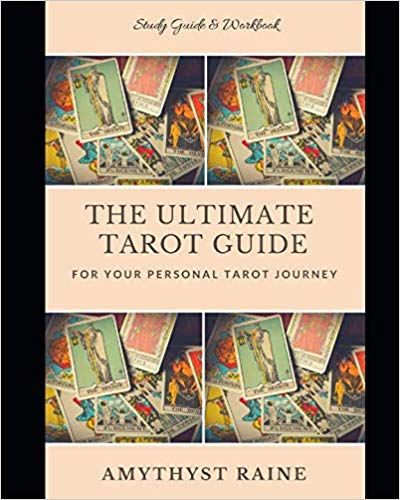The Ultimate Tarot Guide: for Your Personal Tarot Journey
You can purchase your copy @ the link above.

You will need a notebook or three-ring binder and a pen. I recommend the notebook or binder, as opposed to typing your answers/reflections into the computer. A couple reasons for this…handwriting anything puts you closer to the topic and the energy you’re working with. This is why the emailed tarot readings I do are all written out in long-hand first, as I turn the cards, and only then typed into the computer. The second reason is that, at the end of your journey, you will have a keepsake of your adventure, in your own handwriting, to review at your leisure, to use for reflection and meditation.
You will also need a tarot deck to work with. This should be a deck that resonates with you, a deck that you’re comfortable with; but I do suggest that the deck be a standard deck, in that the major arcana, the court cards, and the suits be traditional. I recommend good old Rider/Waite. It’s a traditional set of cards that you may find yourself returning to again and again during a lifetime of tarot study and reading.
The first thing I want to tell you is that the journey you are embarking on right now will be an incredibly personal journey.
These tarot classes are copyrighted material and may not be reproduced in any form, nor may they be displayed to the public through blogs, social websites, personal websites, emails, etc.
You will also need a tarot deck to work with. This should be a deck that resonates with you, a deck that you’re comfortable with; but I do suggest that the deck be a standard deck, in that the major arcana, the court cards, and the suits be traditional. I recommend good old Rider/Waite. It’s a traditional set of cards that you may find yourself returning to again and again during a lifetime of tarot study and reading.
The first thing I want to tell you is that the journey you are embarking on right now will be an incredibly personal journey.
These tarot classes are copyrighted material and may not be reproduced in any form, nor may they be displayed to the public through blogs, social websites, personal websites, emails, etc.
Lesson 2: Interpreting a Three Card Spread
The real knack for tarot reading, and sometimes the most difficult part for some people, is putting the meanings of a group of cards together and making sense from it. This comes with practice, and if you practice enough, it will become second nature. The cards, in fact, will begin to tell you a story.
What you’re doing now is simply learning how to read that story and learning how to apply it to your life and your reality.
I’ve drawn three cards for our spread:
Page of Pentacles…Two of cups…Three of cups
- 1. For each of the three cards listed above, refer back to Lesson 1 for required information about each card. Record this information in your journal.
- 2. Write down the dominate suit for this reading and the subjects connected with this suit. In the case of these three cards, it appears that “Cups” prevails. (the sets, page 146)
- 3. Upon reading the subjects generally touched on by the suit of cups, write down what you think the main topic of this reading will be.
- 4. Let’s learn about the Page of pentacles. Who is he? This is a rogue card, the only card in this reading of another suit. And this card may represent not just a message or messenger, but an individual as well. (court cards, page 225)
- 5. Looking at these cards as a group, write down impressions that come to mind.
As you write, view the cards; and don’t hesitate before jotting something down, even if it seems like something totally irrelevant, weird, or downright out in left field. For instance, if you look at the three of cups and think ‘apples’, write it down. When you’re finished, and don’t rush this process, go back and re-read what you’ve written. Do you see a theme?
- 6. With the information that you have so far, look at these cards, as a group, and write a short story about them (your interpretation of what’s going on here).



No comments:
Post a Comment